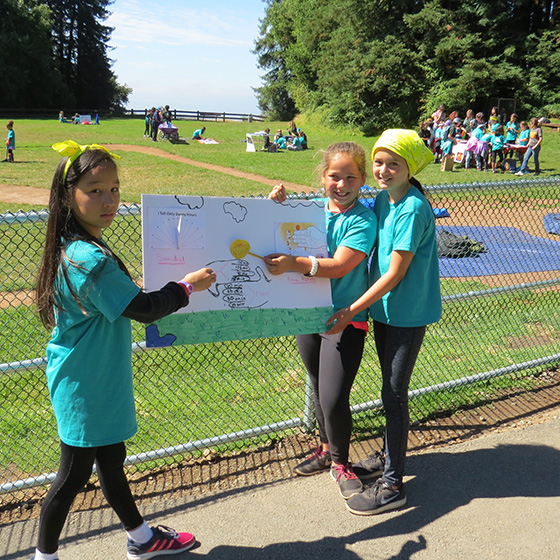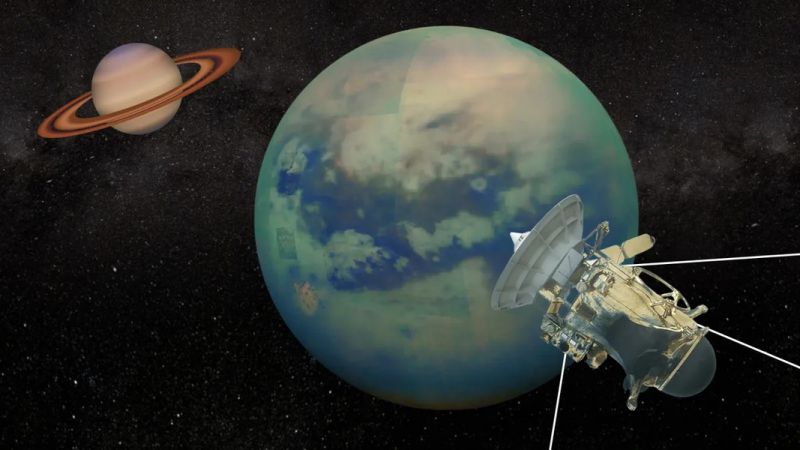
On August 21, as the shadow of the moon races across the continental United States at more than 1,000 miles per hour, Girl Scouts of the USA – councils, volunteers and girls – will be poised to safely view the solar eclipse and engage in the interactive astronomy event of the decade.
A scout tries to get a handle on the way sunlight falls on the Earth. Download full size credit: Girl Scouts of Nothern California
The SETI Institute’s project, “Reaching for the Stars: NASA Science for Girl Scouts,” created activities and tools to prepare the Girl Scouts for the total solar eclipse.
We created ”Eclipse Boxes” featuring 14 activities for Girl Scouts of all ages, including chalk art, modeling magnetism, experimenting with light, scale modeling the solar system, and how eclipses work. Nine activities promote girls’ understanding of our place in the solar system, sun, Earth and moon. Five eclipse activities, resources and safe viewing instructions complete the guide. You can download a copy of the Eclipse Box Activity Guide here. To prepare for the eclipse, Girl Scouts also learned about the sun, Earth and moon at events and summer camps held by 90 Girl Scout councils across the nation.

Three scouts show off what they've learned during final presentations. Download full size credit: Girl Scouts of Nothern California
Many Girl Scouts are traveling to the centerline to observe the total eclipse, partially sponsored by our project. These once-in-a-lifetime trips are part of Girl Scouts of the USA’s Destinations summer travel programs, which offer inspiring travel adventures for older girls, grades 7 – 12.
Three eclipse Destinations will immerse girls in authentic STEM experiences. The three Girl Scout councils hosting Total Eclipse Destinations include
- Girl Scouts of Southern Illinois (Total Eclipse of the Heartland begins with planetarium and science center visits in St. Louis, and transits to Carbondale for the eclipse)
- Girl Scouts of the Missouri Heartland (The Great Eclipse Adventure features hands-on science activities led by Astronomy and Physics faculty and graduate students at University of Missouri, and girls will observe the eclipse near a Girl Scout camp)
- Girl Scouts of South Carolina – Mountains to Midlands (Eyes to the Sky: A Once in a Lifetime Destination visits a Challenger Center, a planetarium, and observatory, and culminates at a Girl Scout camp for eclipse viewing from a mountaintop)
Girl Scouts from across the nation are participating in these Eclipse Destinations as well as watching the total or partial eclipse. All science lovers can purchase safe-viewing eclipse glasses, an eclipse guidebook, an eclipse map, and an eclipse patch for the event at participating Girl Scout council stores.
“Reaching for the Stars: NASA Science for Girl Scouts” is helping Girl Scouts take space science to another level with subject matter experts at the SETI Institute, ARIES Scientific, Inc., Astronomical Society of the Pacific, Girl Scouts of Northern California and University of Arizona.
For more information about Girl Scouts and to join or volunteer, visit www.girlscouts.org/join.
Reaching for the Stars: NASA Science for Girl Scouts is led by subject matter experts at SETI Institute, ARIES Scientific, Inc., Astronomical Society of the Pacific, Girl Scouts of Northern California and University of Arizona. “Reaching for the Stars: NASA Science for Girl Scouts” is based upon work supported by Aerojet Rocketdyne Foundation and NASA Science under cooperative agreement No. NNX16AB90A. Any opinions, findings, and conclusions or recommendations expressed in this material are those of the author(s) and do not necessarily reflect the views of the National Aeronautics and Space Administration.





